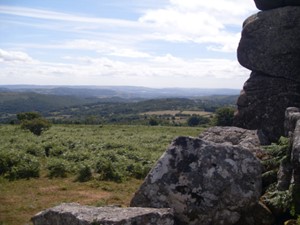Sixty years ago, when I first started to walk on Dartmoor, I wouldn’t have imagined that I’d ever write a novel set there. In fact, I’ve written two Dartmoor fictions, my thriller Dangerous Game, and my historical adventure set upon the Moor – Gibbet Hill, now out..

Writing the new one brought back lots of memories of those early days walking on Dartmoor, both alone and with friends, not to mention the walks with fellow members of the two rambling groups I’ve belonged to – the Moorland RA group and the Teignmouth and Dawlish Ramblers, both of which are still thriving. Memories of walking companions too who are long gone from us.

In the earliest days, I used to catch the bus from Teignmouth, change at Newton Abbot after a hearty breakfast at the now demolished bus station, then walk most of Dartmoor on a rough line between Okehampton and Ivybridge. The eastern half of the Moor came first for me, everywhere you could get to by bus. Good buses too – running lots of cheap services, reliable – you always knew there’d be a late bus to pick you up!

I remember well my first excursions to Moretonhampstead and Manaton, both of which feature in my novel. When I’m writing fiction, the setting always comes before everything. Then some characters, then the sequence of events – I dislike the word plot, it freezes the minds of authors more than anything.
The setting then. Apart from a couple of invented houses, you can walk everywhere mentioned in my new novel. I could almost work out a trail that goes from one location to another, though it would be quite a walk.
When I think of Dartmoor now, I’m really imagining the Dartmoor I first knew – a wilder and lonelier place than it is now. Where you could walk all day and rarely see anyone. Then the evenings at home after the walk, when you’d read the classic writers of Dartmoor. Some of the tales those earlier historians told I’ve incorporated into my book – I’ve always been intrigued by the story of Kitty Jay, the Cry of the Dart, and the demolishing of Irishman’s Wall.
In later years I’d camp for weeks at a time on the old Moor, exploring those areas beyond the reach of a bus, motor cycle and drive to distant places. I well remember the rainy and breezy day I first climbed Gibbet Hill on western Dartmoor, which I’ve used as the title for my novel. It haunted me then as it haunts me still. It’s worth reading what William Crossing writes about it in his books Guide to Dartmoor and A Hundred Years On Dartmoor (do seek them out – near a century after his death, Crossing is still the Master of the Moor.)
I envy those folk who are discovering Dartmoor for the first time – there is no place quite like it. And I’m full of admiration for those brave campaigners who are seeking to see off those Dartmoor landowners who have elbowed aside the ancient traditions, laws and customs of the Moor.
Dartmoor – Wild and Free Forever! #SaveDartmoor

HERE’S MORE ABOUT GIBBET HILL – OUT NOW IN PAPERBACK AND ON KINDLE…
1817: Jonas Lyddon, rebel and revolutionary, returns home to Dartmoor, finding a land beset by trouble. Poverty in the villages and lonely farmsteads. Landowners enclosing the wild stretches of moorland where the poor grazed their animals. A perilous countryside where soldiers – unwanted after the defeat of Napoleon – haunt the woodlands, preying on unwary travellers.
But Jonas Lyddon also encounters the beautiful Kitty Jay and her sister, Tryphena, victims of a cruel society that has cast them aside. Both of them seeking love and belonging. Two women who hold out hope for better and kinder times. Can Jonas Lyddon lead the struggle for justice in this wild place?
Fail and you end your days… hanging on the sinister and windswept Gibbet Hill.